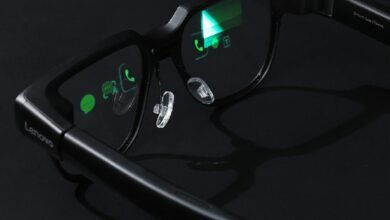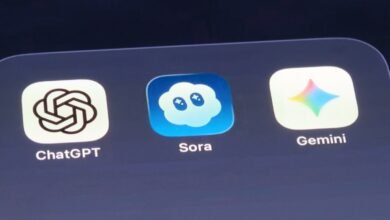Save $120 on Meta Ray-Ban Smart Glasses – Limited Time Offer

▼ Summary
– Meta Ray-Ban Display smart glasses are limited to the US, have long back-orders, and Meta plans to produce only 150,000–200,000 units over two years, fewer than Apple Vision Pro sales.
– Rokid Glasses are a $599 alternative available globally, with a $479 pre-order price on Kickstarter, and have surpassed 300,000 pre-orders, offering unique features like lighter weight and broader prescription support.
– Rokid Glasses outperform Meta’s in areas such as live translation in 89 languages, horizontal photo/video capture, and a brighter, more functional monochrome display, though with some software bugs in ChatGPT integration.
– Meta Ray-Ban Displays excel in features like live conversation captioning, full-color photo previews, superior sound quality, discreet display with minimal light leakage, and stylish Ray-Ban designs with transition lenses.
– Both products are best suited for tech enthusiasts, with Rokid being more functional and affordable for tasks like translation, while Meta offers a more futuristic and stylish experience but at a higher price.
Finding a pair of Meta Ray-Ban Display smart glasses can be a real challenge. They are currently only sold in the United States, face significant back-orders stretching for weeks or even months, and production is reportedly capped at a limited number of units for the foreseeable future. For tech enthusiasts and professionals outside the US, or for those seeking a more accessible and feature-rich alternative, Rokid Glasses present a compelling option at a substantially lower price point.
Having spent several weeks testing the Rokid Glasses, I’ve identified several areas where they outperform the more expensive Meta offering. Conversely, Meta’s glasses do hold advantages in specific categories. Here’s a detailed breakdown based on hands-on experience with both devices.
Where Rokid Glasses Excel
Comfort and Weight: A noticeable difference lies in how they feel. The Rokid Glasses are significantly lighter at just 49 grams, compared to the 69 grams of the Meta Ray-Ban Displays. This, combined with nosepads that lift the frames slightly off your nose, makes the Rokid model feel more comfortable for extended wear.
Live Translation Capabilities: This is a standout feature. Rokid Glasses support real-time translation across 89 languages, leveraging Microsoft’s translation software. In contrast, the Meta glasses currently handle only five languages, with plans to add two more. During testing, the Rokid translation was impressively functional, providing enough accuracy to grasp the essence of conversations in unfamiliar languages.
Photography and Video Flexibility: One common critique of Meta’s glasses is their limitation to a 4×3 vertical shooting mode. Rokid addresses this directly by offering multiple aspect ratios, including 9×16 vertical and, more importantly, 3×4 horizontal photos and videos. I found myself using the horizontal mode frequently, as it feels more natural for capturing scenes.
AI Engine: Rokid utilizes the powerful ChatGPT as its AI engine, a notable advantage over Meta’s reliance on its own Llama models. It’s important to note that the ChatGPT integration in the pre-production unit I tested still had some software bugs to iron out, such as the inability to ask follow-up questions and occasional glitches in the audio responses.
Display Brightness and Functionality: While Meta boasts a 5,000 nit color display in one eye, Rokid employs a 1,500 nit monochrome green display in both eyes. In practical use, the Rokid display appears brighter and is easier to read, especially with adjustable text positioning and brightness settings. The result is a highly functional screen, even if it lacks the visual appeal of a full-color display.
Built-in Teleprompter: The bright display enables a useful teleprompter feature. For content creators, public speakers, or meeting leaders, this tool can be incredibly valuable. The AI that automatically scrolls the text as you read worked reliably in testing, making it a practical everyday aid. A minor drawback is that the green display can be visible to others.
Prescription Lens Support: Rokid offers far greater flexibility for those who need vision correction. They support a much wider prescription range and feature an innovative magnetic system for the corrective lenses. This allows for easy swapping if your prescription changes or if you want to remove them to wear contact lenses.
Where Meta Ray-Ban Display Glasses Have the Edge
Live Conversation Captioning: A fantastic feature exclusive to Meta is the ability to display live captions of in-person conversations. This can be a game-changer for understanding people in noisy environments or for those with hearing difficulties.
Photo and Video Preview: Meta glasses provide a full-color preview and viewfinder directly in your line of sight. This elevates the photography experience, giving you a much better idea of your final shot compared to the basic visual guide on the Rokid Glasses.
Audio Quality: The sound and microphone quality on the Meta glasses are exceptional. They deliver a level of clarity and depth in audio playback and recording that is a clear step above the solid but unremarkable performance of the Rokid Glasses.
Discreet Design: Meta has achieved a remarkable feat in minimizing light leakage. It is nearly impossible for others to tell when you are actively using the display. With Rokid Glasses, the green light is more apparent, and the design of the lenses makes it obvious you are wearing a tech product, even when the screen is off.
Transition Lenses and Style: All Meta models come with transition lenses that automatically darken in sunlight, effectively combining regular glasses and sunglasses. From a fashion standpoint, the Meta Ray-Ban Displays are undeniably more stylish. They look and feel like a classic pair of Wayfarers, with a design that sits naturally on the nose. Rokid’s single glossy black frame and elevated fit can appear slightly less polished.
Neural Interface Control: The optional Neural Band wristband for the Meta glasses introduces a novel control scheme using hand gestures. This gesture-based interface is intuitive and quickly learned, opening up new interaction possibilities without touching the glasses. However, the band’s single-purpose nature feels limiting.
Final Considerations
It’s important to recognize that neither of these smart glasses is yet a must-have product for the average consumer. They are primarily for early adopters eager to experiment with cutting-edge technology.
However, the Rokid Glasses make a very strong case for themselves based on current functionality. They are more versatile and practical for a wider range of tasks today, all while costing $200 less than the Meta Ray-Ban Displays. For travelers or anyone who frequently needs cross-language communication, the live translation feature alone could be transformative. The current Kickstarter pre-order campaign, offering them for just $479 until October 10, makes them an even more attractive proposition for those ready to dive into the world of smart glasses.
(Source: ZDNET)




